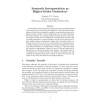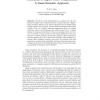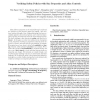27 search results - page 3 / 6 » A logical analysis of aliasing in imperative higher-order fu... |
JELIA
1990
Springer
13 years 11 months ago
1990
Springer
Traditional accounts of the semantic interpretation of quantified phrases and its interaction with reference and ellipsis have relied on formal manipulations of logical forms (qua...
ESOP
2008
Springer
13 years 9 months ago
2008
Springer
Abstract. We survey recent developments in an approach to the verification of higher-order computation based on game semantics. Higherorder recursion schemes are in essence (progra...
POPL
2010
ACM
14 years 5 months ago
2010
ACM
We introduce higher-order, multi-parameter, tree transducers (HMTTs, for short), which are kinds of higher-order tree transducers that take input trees and output a (possibly infi...
LDVF
2000
13 years 7 months ago
2000
The aim of this paper is to provide an analysis of the function of imperatives in dialogue. In particular, the focus is on the use of logically complex imperatives (e.g., `Say hel...
ICSE
2005
IEEE-ACM
14 years 7 months ago
2005
IEEE-ACM
Many software properties can be analysed through a relational size analysis on each function's inputs and outputs. Such relational analysis (through a form of dependent typin...



